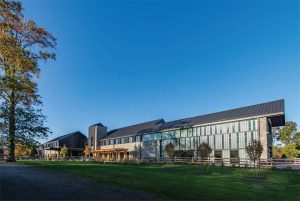
Like most projects, architectural choices in education projects are incredibly complex. Many decisions including critical energy performance and efficiency choices are especially crucial. The biggest influencers are the community and site where the school is being built. Also important are budget and requirements for specialty spaces; gymnasiums and auditoriums are large masses that influence school design. For the best impact and service to the community, every decision—from large roofing components to small bathroom fixtures and paint colors—are carefully chosen.
While many of those choices are sophisticated and require extensive building expertise to make a cohesive design solution, the first decision is rather simple. As reflected in so much of the world, that selection revolves around the sun. To achieve optimal energy performance and efficiency, the first and foremost decision is the building complex placement on site. A school’s orientation in relation to the sun can determine school effectiveness for helping the main reason it is being built—for students. Daylight, and how it is balanced, manipulated, and utilized, is one of the primary design considerations facing school architects.
“Every site is different, and every site has different constraints,” says Laura Wernick of HMFH Architects. “But if we can get the majority of the classrooms facing north and south, that really is a first important step for getting good, balanced daylighting in the classroom.”
Daylight is one of the most important elements because significant amounts of data within the past two decades indicates that daylighting improves student performance. Achieving the right balance is tricky. Like Goldilocks and the porridge, there can’t be too much or too little.
Architects have a range of choices to influence the building design envelope and fenestration to determine how much daylighting penetrates buildings. At Johnson County Community College in Kansas, BNIM Architects used fritted glass, combined with an etched glass on surface #4, to create a strong light diffusing effect. Another example is at Kean University in New Jersey, where NK Architects used double-glazed, low emissivity (low-e) coated channel glass walls with different textures, installed in thermally broken frames to integrate their design aesthetic.
As technology advances and supports designers’ choices, so do the technical options for architects designing schools. Today, there are programs that help determine designs which achieve the optimal daylighting balance. Gone are the days of rectilinear schools being constructed with ceiling to floor unfiltered glass or light-defying structures heavy on brick and mortar. These schools are now just as rare as the one-room schoolhouse because of this understanding of how light affects the education process.
Abundantly Clear Data
Daylighting and its impact on student performance has been evident for more than two decades. The most influential report came from a study by the Heschong Mahone Group for Pacific Gas & Electric Company in 1999. The conclusion in this report from 21,000 students tested in three states found students in classrooms with the most daylighting progressed 20 percent faster on math tests and 26 percent faster on reading tests in one year than those with less amount of daylighting.
Since that groundbreaking study, subsequent tests have found similar conclusions aligning with these choices. One of the most recent studies came in 2020, by Sinphonie Consortium, which found European students in classrooms with proper daylighting performed better in math and logic tests.
“Overall, our findings suggest classroom characteristics associated with daylighting do significantly impact the performance of the school children and may account for more than 20 percent of the variation between performance test scores,” the report concludes.
Natural light does more than boost student performance; it can also impact health. Studies show natural light can boost the body’s vitamin D storage, improve mood, reduce depression, improve sleep and circadian regulation, and relieve Season Affective Disorder (SAD). The Center for Educational Improvement (CEI) wrote: while “there is no consensus” on the cause of SAD, “there is indirect evidence that supports the idea that reduced sunlight exposure is a major factor.”
Daylighting can also impact the building’s lighting, heating, and cooling costs for the lifecycle of operation. U.S. school systems spend approximately $8 billion each year on energy. According to the U.S. Energy Information Administration, about 26 percent of electricity consumed by a typical school is for lighting.
With so much riding on the outcome—educationally, financially, and physically—architects should weigh every daylighting choice with precision and technology when available.
“The research seems abundantly clear,’’ says Andrew Lewis of NK Architects. “It’s important to understand the passage of time, and how light moves throughout the course of a day. Education in a school where the quality of light changes throughout the day is not the greatest place to learn. Having views to the outdoors is also important. Even in healthcare work, the research is even more clear. People who are in a hospital room recover faster when they have a view and can see nature.”




